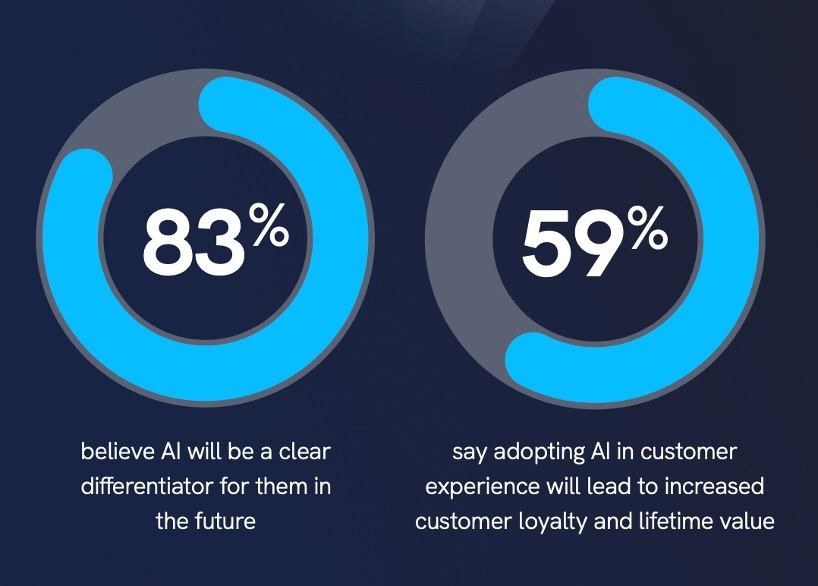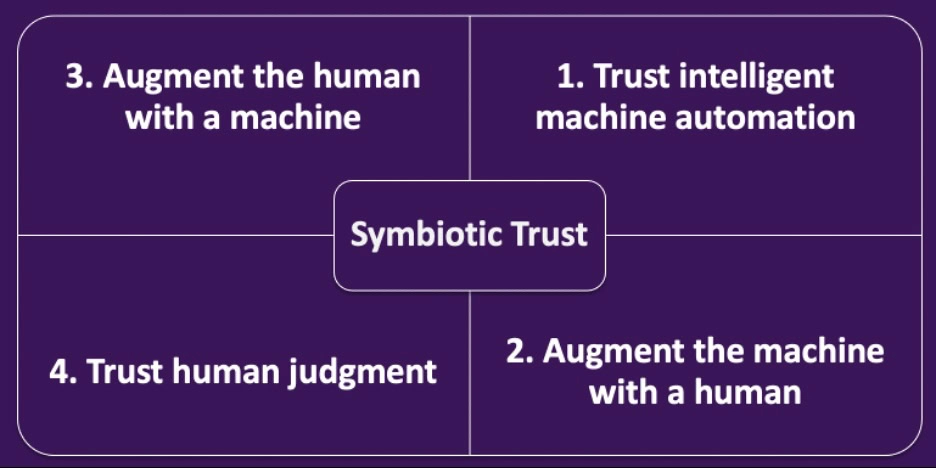Your Genesys Blog Subscription has been confirmed!
Please add genesys@email.genesys.com to your safe sender list to ensure you receive the weekly blog notifications.
Subscribe to our free newsletter and get blog updates in your inbox
Don't Show This Again.

Genesys recently released a survey of 1,000 customer experience (CX) leaders worldwide on their use or plans to use artificial intelligence (AI). Constellation Research was interviewed for the report and shared our perspectives in an accompanying webinar. It’s clear from the findings that AI will create CX differentiation — and CX leaders intend to bet big.
The good news: 70% report that AI is a key business imperative — with 27% already viewing it as crucial to their CX operations. Forty-three percent expect AI to be critical in the next two to three years. From our perspective, AI is top of mind and well-funded by boards for early adopters.
The bad news: Those who wait too long to take action may fall behind.
In fact, in the report, over 83% of CX leaders believe AI will be a clear differentiator for them in the future. And 59% say AI adoption in customer experience will lead to increased customer loyalty and lifetime value (see Figure 1).

Figure 1. AI is a clear differentiator.
This is especially important considering research from Capgemini, which indicates that consumers are actively seeking out AI in both their personal and work lives. In fact, 56% of consumers admit they already actively use AI in their work, while 53% of consumers claim they already entrust generative AI tools to assist with key personal life demands, including financial planning.
While enterprises seeking out opportunities for operational optimization through automation drove the earlier waves of AI adoption, consumer demand for AI is accelerating this new wave of AI innovation.
Constellation Research sees five key use cases for AI across CX among an infinite permutation of possibilities.
1. Marketing: Diffusion models will dynamically generate content, provide translation capability and proactively initiate experimentation testing — from simple A/B scenarios to more complex multivariate tests — to optimize user experiences. Personalization models will gain greater context, enabling hypertargeting for campaigns, ad networks and polling with ChatGPT.
Customer listening will expand in scope and scale, enabling active listening posts to be aggregated and analyzed for more robust and contextual intelligence. AI will also extend the capacity to generate and iterate on content and assets that were once held exclusively in marketing tools. This will empower service and sales teams — especially critical front-line CX teams in the contact center — to access, personalize and generate brand-compliant assets from centralized content, asset and knowledge bases.
2. Sales: Sales-specific tasks, such as pipeline reviews, meeting scheduling, installed-base analysis and forecasting will move from manual to automated processes. Ticklers and alerts will remind sales reps to follow up on actions.
Brand voice will be automatically infused into generated communications via predictive, highly personalized and globally contextual automated event-based triggers. Language models will eliminate the awkwardness of transactional conversations. The capacity to sell anywhere will extend across the CX landscape, as AI recommendations for up-selling and cross-selling empower both live and autonomous agents to deliver highly contextual and relevant recommendations to customers.
3. Service: Crawlers inside an organization’s internal systems will scan knowledge bases, augment case history and hasten issue resolution. Agent empowerment will get an immediate infusion of automation and intelligence in the form of everything from recommended scripts to responses or reactions.
Smart routing of calls, messages and other communications will seamlessly connect the right customer to the “exactly right” internal expert or agent. AI will create new case tickets, augment missing information, predict customer satisfaction with improved sentiment analysis, and proactively trigger communications to address issues before they become customer problems.
GPT-powered bots will offload communications and connections, leaving agents with more time and focus to address higher-level situations that will have a more direct impact on bottom-line growth. Thanks to AI, human agents will be augmented and elevated to expert status.
In the contact center, agents and supervisors will have access to workforce optimization enhancements once thought of as too complex to deploy, from dynamic shift-swapping to AI-generated resource scheduling based on diverse variables, including skills and expertise in operational moments of need. Teams will have access to experts and customers worldwide, thanks to language models infused with multilingual translation and conversation generation, removing barriers between expertise and demand.
4. Commerce: Speed and personalization of product catalog creation will improve as diffusion models take prompts from regulatory requirements, enabling faster global rollouts of new product and services content. Conversational generative GPT models will serve as the front-end interface for order capture enhanced by visuals generated according to customer-specified configurations.
5. Customer success: AI will identify accounts with low adoption and automatically pinpoint at-risk customers based on their levels of interaction, initiating workflows to increase the frequency of engagement. Generative AI will predict the best cadence and content of these automated interactions to guide at-risk customers into optimized, personalized and highly contextual journeys.
Expect dynamic polling to generate surveys based on parameters such as monetary value, length of relationship, past interactions and customer satisfaction. Digital adoption strategies will be rewritten as AI predictions, and automated content generation will tailor engagements and multichannel communications to best guide users to a more effective and optimized onboarding, training and utilization roadmaps.
Highlights from the survey show an emerging empathetic approach to CX differentiation, with opportunities to expand AI adoption and usage. While chatbots currently dominate the use cases, with 88% of organizations using this technology, fewer than a quarter of CX leaders who responded use the following approaches:
This is not surprising as CX leaders, especially those in the contact center, are well-versed in successfully deploying the first wave of interactive communications with interactive voice recordings (IVR). And they’ve already shifted to more sophisticated intelligent virtual agents (IVA) to accelerate self-service engagements.
The next opportunity is to move beyond IVR, IVA, chatbots and predictive analytics to improve overall CX and better connect the engagements in individual silos of CX to a more comprehensive enterprise-wide strategy that’s purpose-built to establish durable, resilient, profitable relationships with customers.
When a comprehensive strategy is in place, the customer journey is more connected, both internally and externally. Predictive, automated empathetic journeys drive repeat business and improve loyalty.
Sentiment and empathy analysis will assist with coaching and training for real-time improvement. Critical high-fidelity signals are pulled into a connected interaction data view that shares key moments of customer exploration on marketing-developed digital engagements directly into the view of an autonomous agent. That agent can now generate a fresh, contextual self-service engagement in a mobile environment.
Providing contextually relevant knowledge enables faster live agent response times and turns every first-touch resolution into an opportunity for empowered agents to improve customer satisfaction. In addition, personalization and customer understanding lead to higher conversion rates and average order values, as empathy drives deeper conversations and opportunities to better cross-sell and turn interactions with agents into a winning commerce experience. The aggregation of these intelligent experiences empowers customer success agents to more predictively time renewal outreach.
Knowing that proactive and efficient service builds customer retention over time, AI and automation will deliver not just on cost optimization and operational efficiency. It will also help contribute to revenue across the CX ecosystem.
Organizational success requires more than large language learning models or better algorithms. CX leaders will need to identify the largest corpus of data available, the CX questions to be answered, and the skills required in a world where humans and machines work side-by-side.
In core CX processes, such as campaign to lead, lead to order capture, order capture to order fulfillment, order fulfillment to order completion, and incident to resolution, there will be opportunities for generative AI to provide missing content and context along the way.
In the recent Salesforce State of Service study, 61% of consumers admit they would actually prefer a self-service agent experience to resolve simple issues or needs. But CX leaders beware: 72% note that they would not return to that bot after a single negative experience.
Every CX leader must determine which customer or employee journeys should be fully automated, as opposed to those that should augment the machine with a human, augment a human with a machine or instead require a human touch (see Figure 2). This matrix of “symbiotic trust” can be leveraged to assess the level of trust an organization can place on the data, models and operations guiding these stages of AI-driven augmentation and automation.

As the Genesys research found, 83% of CX leaders understand that AI holds the potential to differentiate for customers and employees alike. Customers expect AI to be a readily available resource. And many organizations have already started down the path to the truly intelligent enterprise, dabbling in IVAs or chatbots in isolated experiments or use cases.
It’s clear that the time is now to expand the aperture of where AI can and should exist across the CX ecosystem. The consumer call for companies to be on this AI journey is loud and clear. How CX leaders respond and deliver on a truly connected and integrated AI empowered experience is the opportunity of today.
To learn more about how to make AI work for your customers, your employees and your organization, read “Customer Experience in the Age of AI” today.
Subscribe to our free newsletter and get blog updates in your inbox.
Related capabilities: